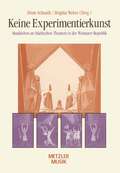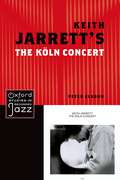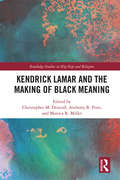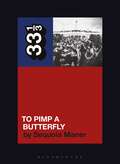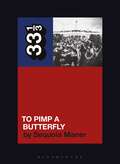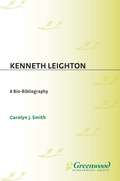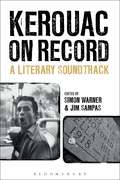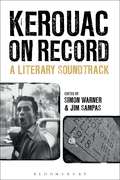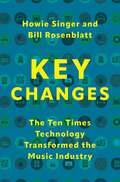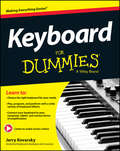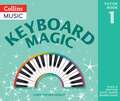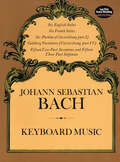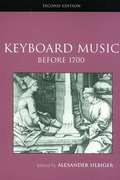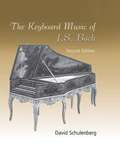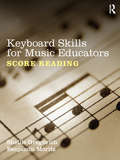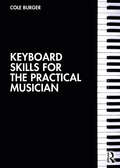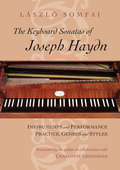- Table View
- List View
Keith Jarrett's The Koln Concert (Oxford Studies in Recorded Jazz)
by Peter ElsdonKeith Jarrett ranks among the most accomplished and influential pianists in jazz history. His The Köln Concert stands among the most important jazz recordings of the past four decades, not only because of the music on the record, but also because of the remarkable reception it has received from musicians and lay-listeners alike. Since the album's 1975 release, it has sold over three million copies: a remarkable achievement for any jazz record, but an unprecedented feat for a two-disc set of solo piano performances featuring no well-known songs. In Keith Jarrett's The Köln Concert, author Peter Elsdon seeks to uncover what it is about this recording, about Keith Jarrett's performance, that elicits such success. Recognizing The Köln Concert as a multi-faceted text, Elsdon engages with it musically, culturally, aesthetically, and historically in order to understand the concert and album as a means through which Jarrett articulated his own cultural and musical outlook, and establish himself as a serious artist. Through these explorations of the concert as text, of the recording and of the live performance, Keith Jarrett's The Köln Concert fills a major hole in jazz scholarship, and is essential reading for jazz scholars and musicians alike, as well as Keith Jarrett's many fans.
Keith Jarrett's The Koln Concert (Oxford Studies in Recorded Jazz)
by Peter ElsdonKeith Jarrett ranks among the most accomplished and influential pianists in jazz history. His The Köln Concert stands among the most important jazz recordings of the past four decades, not only because of the music on the record, but also because of the remarkable reception it has received from musicians and lay-listeners alike. Since the album's 1975 release, it has sold over three million copies: a remarkable achievement for any jazz record, but an unprecedented feat for a two-disc set of solo piano performances featuring no well-known songs. In Keith Jarrett's The Köln Concert, author Peter Elsdon seeks to uncover what it is about this recording, about Keith Jarrett's performance, that elicits such success. Recognizing The Köln Concert as a multi-faceted text, Elsdon engages with it musically, culturally, aesthetically, and historically in order to understand the concert and album as a means through which Jarrett articulated his own cultural and musical outlook, and establish himself as a serious artist. Through these explorations of the concert as text, of the recording and of the live performance, Keith Jarrett's The Köln Concert fills a major hole in jazz scholarship, and is essential reading for jazz scholars and musicians alike, as well as Keith Jarrett's many fans.
Kendrick Lamar and the Making of Black Meaning (Routledge Studies in Hip Hop and Religion)
by Christopher M. Driscoll Monica R. Miller Anthony B. PinnKendrick Lamar has established himself at the forefront of contemporary hip-hop culture. Artistically adventurous and socially conscious, he has been unapologetic in using his art form, rap music, to address issues affecting black lives while also exploring subjects fundamental to the human experience, such as religious belief. This book is the first to provide an interdisciplinary academic analysis of the impact of Lamar’s corpus. In doing so, it highlights how Lamar’s music reflects current tensions that are keenly felt when dealing with the subjects of race, religion and politics. Starting with Section 80 and ending with DAMN., this book deals with each of Lamar’s four major projects in turn. A panel of academics, journalists and hip-hop practitioners show how religion, in particular black spiritualties, take a front-and-center role in his work. They also observe that his astute and biting thoughts on race and culture may come from an African American perspective, but many find something familiar in Lamar’s lyrical testimony across great chasms of social and geographical difference. This sophisticated exploration of one of popular culture’s emerging icons reveals a complex and multi faceted engagement with religion, faith, race, art and culture. As such, it will be vital reading for anyone working in religious, African American and hip-hop studies, as well as scholars of music, media and popular culture.
Kendrick Lamar and the Making of Black Meaning (Routledge Studies in Hip Hop and Religion)
by Christopher M. Driscoll Monica R. Miller Anthony B. PinnKendrick Lamar has established himself at the forefront of contemporary hip-hop culture. Artistically adventurous and socially conscious, he has been unapologetic in using his art form, rap music, to address issues affecting black lives while also exploring subjects fundamental to the human experience, such as religious belief. This book is the first to provide an interdisciplinary academic analysis of the impact of Lamar’s corpus. In doing so, it highlights how Lamar’s music reflects current tensions that are keenly felt when dealing with the subjects of race, religion and politics. Starting with Section 80 and ending with DAMN., this book deals with each of Lamar’s four major projects in turn. A panel of academics, journalists and hip-hop practitioners show how religion, in particular black spiritualties, take a front-and-center role in his work. They also observe that his astute and biting thoughts on race and culture may come from an African American perspective, but many find something familiar in Lamar’s lyrical testimony across great chasms of social and geographical difference. This sophisticated exploration of one of popular culture’s emerging icons reveals a complex and multi faceted engagement with religion, faith, race, art and culture. As such, it will be vital reading for anyone working in religious, African American and hip-hop studies, as well as scholars of music, media and popular culture.
Kendrick Lamar's To Pimp a Butterfly (33 1/3)
by Sequoia ManerBreaking the global record for streams in a single day, nearly 10 million people around the world tuned in to hear Kendrick Lamar's sophomore album in the hours after its release. To Pimp a Butterfly was widely hailed as an instant classic, garnering laudatory album reviews, many awards, and even a canonized place in Harvard's W. E. B. Du Bois archive. Why did this strangely compelling record stimulate the emotions and imaginations of listeners?This book takes a deep dive into the sounds, images, and lyrics of To Pimp a Butterfly to suggest that Kendrick appeals to the psyche of a nation in crisis and embraces the development of a radical political conscience. Kendrick breathes fresh life into the Black musical protest tradition and cultivates a platform for loving resistance. Combining funk, jazz, and spoken word, To Pimp a Butterfly's expansive sonic and lyrical geography brings a high level of innovation to rap music. More importantly, Kendrick's introspective and philosophical songs compel us to believe in a future where, perhaps, we gon' be alright.
Kendrick Lamar's To Pimp a Butterfly (33 1/3)
by Sequoia ManerBreaking the global record for streams in a single day, nearly 10 million people around the world tuned in to hear Kendrick Lamar's sophomore album in the hours after its release. To Pimp a Butterfly was widely hailed as an instant classic, garnering laudatory album reviews, many awards, and even a canonized place in Harvard's W. E. B. Du Bois archive. Why did this strangely compelling record stimulate the emotions and imaginations of listeners?This book takes a deep dive into the sounds, images, and lyrics of To Pimp a Butterfly to suggest that Kendrick appeals to the psyche of a nation in crisis and embraces the development of a radical political conscience. Kendrick breathes fresh life into the Black musical protest tradition and cultivates a platform for loving resistance. Combining funk, jazz, and spoken word, To Pimp a Butterfly's expansive sonic and lyrical geography brings a high level of innovation to rap music. More importantly, Kendrick's introspective and philosophical songs compel us to believe in a future where, perhaps, we gon' be alright.
Kenneth Leighton: A Bio-Bibliography (Bio-Bibliographies in Music)
by Carolyn J. SmithKenneth Leighton, best known for his organ and sacred choral music, was a composer of great depth and talent who wrote a significant body of works. Many of those works were written for large orchestras and a significant number of pieces of chamber music were composed for a variety of instrument groupings, as well as for instrumental solos. Anyone interested in 20th-century music as well as British and Scottish Cathedral music will find a wealth of works listed with a description of each.Kenneth Leighton, best known for his organ and sacred choral music, was a composer of great depth and talent who wrote a significant body of works. Many of those works were written for large orchestras and a significant number of pieces of chamber music were composed for a variety of instrument groupings, as well as for instrumental solos. Anyone interested in 20th-century music as well as British and Scottish Cathedral music will find a wealth of works listed with a description of each.This volume begins with a brief biography of Leighton and is followed by an alphabetical listing of works and performances. Also included is a discography and a bibliography of articles, reviews, books, and dissertations. The last section is a chronological list of compositions. Smith helps us to realize that Kenneth Leighton was an extraordinary composer of 20th-century music with a varied body of works and also a virtuoso pianist of some note.
Kerouac on Record: A Literary Soundtrack (PDF)
by Professor Simon Warner Mr Jim SampasHe was the leading light of the Beat Generation writers and the most dynamic author of his time, but Jack Kerouac also had a lifelong passion for music, particularly the mid-century jazz of New York City, the development of which he witnessed first-hand during the 1940s with Charlie Parker, Dizzy Gillespie and Thelonious Monk to the fore. The novelist, most famous for his 1957 book On the Road, admired the sounds of bebop and attempted to bring something of their original energy to his own writing, a torrent of semi-autobiographical stories he published between 1950 and his early death in 1969. Yet he was also drawn to American popular music of all kinds – from the blues to Broadway ballads – and when he came to record albums under his own name, he married his unique spoken word style with some of the most talented musicians on the scene. Kerouac's musical legacy goes well beyond the studio recordings he made himself: his influence infused generations of music makers who followed in his work – from singer-songwriters to rock bands. Some of the greatest transatlantic names – Bob Dylan and the Grateful Dead, Van Morrison and David Bowie, Janis Joplin and Tom Waits, Sonic Youth and Death Cab for Cutie, and many more – credited Kerouac's impact on their output. In Kerouac on Record, we consider how the writer brought his passion for jazz to his prose and poetry, his own record releases, the ways his legacy has been sustained by numerous more recent talents, those rock tributes that have kept his memory alive and some of the scores that have featured in Hollywood adaptations of the adventures he brought to the printed page.
Kerouac on Record: A Literary Soundtrack
by Professor Simon Warner Mr Jim SampasHe was the leading light of the Beat Generation writers and the most dynamic author of his time, but Jack Kerouac also had a lifelong passion for music, particularly the mid-century jazz of New York City, the development of which he witnessed first-hand during the 1940s with Charlie Parker, Dizzy Gillespie and Thelonious Monk to the fore. The novelist, most famous for his 1957 book On the Road, admired the sounds of bebop and attempted to bring something of their original energy to his own writing, a torrent of semi-autobiographical stories he published between 1950 and his early death in 1969. Yet he was also drawn to American popular music of all kinds – from the blues to Broadway ballads – and when he came to record albums under his own name, he married his unique spoken word style with some of the most talented musicians on the scene. Kerouac's musical legacy goes well beyond the studio recordings he made himself: his influence infused generations of music makers who followed in his work – from singer-songwriters to rock bands. Some of the greatest transatlantic names – Bob Dylan and the Grateful Dead, Van Morrison and David Bowie, Janis Joplin and Tom Waits, Sonic Youth and Death Cab for Cutie, and many more – credited Kerouac's impact on their output. In Kerouac on Record, we consider how the writer brought his passion for jazz to his prose and poetry, his own record releases, the ways his legacy has been sustained by numerous more recent talents, those rock tributes that have kept his memory alive and some of the scores that have featured in Hollywood adaptations of the adventures he brought to the printed page.
Key Changes: The Ten Times Technology Transformed the Music Industry
by Howie Singer Bill RosenblattTells a new story about the history of the music business and the ten technological advances that disrupted it over the last century. In recent years, narratives about the music industry tend to hew to a common theme: it was humming along for decades until the Internet and Napster came along and disrupted it. Key Changes shows that this view is incorrect: the industry was actually shaken up not once in the 1990s, but ten times over more than 100 years. These ten disruptions came with the introduction of new formats for enjoying recorded music: starting with the cylinders and discs played on early phonographs; then moving through radio, LPs, tapes, CDs, television, digital downloads, streaming, and streaming video; and then into Artificial Intelligence (AI), which enables a wide range of new capabilities with profound impacts upon the business. This book devotes a chapter to each of these formats, illustrating how such innovations beget shifts in creativity, consumer behavior, economics, and law. Each of the technological innovations covered in this book not only disrupted the music business, but also fundamentally altered the industry's character. And while the technologies themselves have evolved in unique and varied ways over the decades, the changes within the business follow a clear pattern. Veteran music industry professionals and music technology experts Howie Singer and Bill Rosenblatt illuminate this pattern through a framework they term "the 6 Cs": cutting edge technology, channels of distribution, creators, consumers, cash, copyright. This framework provides insight into how such disparate innovations similarly disrupted and transformed the music business in each era. Extensively researched and supplemented by interviews with Grammy-winning artists, producers and executives, the book provides an insightful perspective on the ways technology has fundamentally altered the music industry, throughout history and into the present era.
Key Changes: The Ten Times Technology Transformed the Music Industry
by Howie Singer Bill RosenblattTells a new story about the history of the music business and the ten technological advances that disrupted it over the last century. In recent years, narratives about the music industry tend to hew to a common theme: it was humming along for decades until the Internet and Napster came along and disrupted it. Key Changes shows that this view is incorrect: the industry was actually shaken up not once in the 1990s, but ten times over more than 100 years. These ten disruptions came with the introduction of new formats for enjoying recorded music: starting with the cylinders and discs played on early phonographs; then moving through radio, LPs, tapes, CDs, television, digital downloads, streaming, and streaming video; and then into Artificial Intelligence (AI), which enables a wide range of new capabilities with profound impacts upon the business. This book devotes a chapter to each of these formats, illustrating how such innovations beget shifts in creativity, consumer behavior, economics, and law. Each of the technological innovations covered in this book not only disrupted the music business, but also fundamentally altered the industry's character. And while the technologies themselves have evolved in unique and varied ways over the decades, the changes within the business follow a clear pattern. Veteran music industry professionals and music technology experts Howie Singer and Bill Rosenblatt illuminate this pattern through a framework they term "the 6 Cs": cutting edge technology, channels of distribution, creators, consumers, cash, copyright. This framework provides insight into how such disparate innovations similarly disrupted and transformed the music business in each era. Extensively researched and supplemented by interviews with Grammy-winning artists, producers and executives, the book provides an insightful perspective on the ways technology has fundamentally altered the music industry, throughout history and into the present era.
Keyboard For Dummies
by Jerry KovarskyThe easy way to get keyed up on the keyboard Where Piano For Dummies helps budding musicians to master the black-and-white musical keyboard, Keyboard For Dummies helps them understand the possibilities that unfold when those black-and-whites are connected to state-of-the-art music technology. Keyboard For Dummies explains the ins-and-outs of modern keyboards and helps you get the most out of their capabilities. Key content coverage includes: an overview of the types of keyboards available today and how they differ from acoustic pianos; expert advice on choosing the right keyboard for your wants/needs and how to shop and compare the various models; a close look at the types of sounds an electronic keyboard offers and how to achieve them; step-by-step instruction on how to use keyboards anywhere using external speakers, amps, home stereos, computers, and tablets; guidance on how to use keyboard software and applications to get the most out of keyboard technology; and much more. A multimedia component for this title will be hosted at Dummies.com and includes companion audio tracks that demonstrate techniques and sounds found in the book Step-by-step instructions make learning keyboard easy and fun Introduces you to the musical possibilities of the keyboard If you're new to the keyboard or looking to take your skills to the next level, Keyboard For Dummies is a thorough guide to the ins and outs of this popular instrument.
Keyboard For Dummies
by Jerry KovarskyThe easy way to get keyed up on the keyboard Where Piano For Dummies helps budding musicians to master the black-and-white musical keyboard, Keyboard For Dummies helps them understand the possibilities that unfold when those black-and-whites are connected to state-of-the-art music technology. Keyboard For Dummies explains the ins-and-outs of modern keyboards and helps you get the most out of their capabilities. Key content coverage includes: an overview of the types of keyboards available today and how they differ from acoustic pianos; expert advice on choosing the right keyboard for your wants/needs and how to shop and compare the various models; a close look at the types of sounds an electronic keyboard offers and how to achieve them; step-by-step instruction on how to use keyboards anywhere using external speakers, amps, home stereos, computers, and tablets; guidance on how to use keyboard software and applications to get the most out of keyboard technology; and much more. A multimedia component for this title will be hosted at Dummies.com and includes companion audio tracks that demonstrate techniques and sounds found in the book Step-by-step instructions make learning keyboard easy and fun Introduces you to the musical possibilities of the keyboard If you're new to the keyboard or looking to take your skills to the next level, Keyboard For Dummies is a thorough guide to the ins and outs of this popular instrument.
Keyboard Magic - Keyboard Magic: Pupil's Book (with Downloads)
by Christopher HusseyThis fun and approachable method introduces young people to the keyboard through enjoyable activities and pieces.
Keyboard Music
by Johann Sebastian BachThe renowned Bach-Gesellschaft, founded in 1850 to collect, edit, and publish all the known works of J. S. Bach, devoted fifty years to its monumental task. It succeeded so well in tracking down Bach's heritage, establishing authenticity, and transcribing accurate texts that it still remains the primary source for Bach's music., Unfortunately, it has always been a fantastically expensive publication, accessible only in the largest libraries.This volume reprints in full, directly from the Bach-Gesellschaft volumes, important keyboard music. It contains the full texts of the Six English Suites, the Six French Suites, Six Partitas from the Clavierübung, the Goldberg Variations, and the Two- and Three-Part Inventions and Sinfonias,The music has been reproduced in large, clear type, directly from the original editions, for maximum clarity. Designed as a playing edition, it will be a necessary book to every performer on the harpsichord or piano, every music student and musicologist, as well as to serious music listeners.
Keyboard Music Before 1700 (Studies In Musical Genres And Repertories)
by Alexander SilbigerKeyboard Music Before 1700 begins with an overview of the development of keyboard music in Europe. Then, individual chapters by noted authorities in the field cover the key composers and repertory before 1700 in England, France, Germany and the Netherlands, Italy, and Spain and Portugal. The book concludes with a chapter on performance practice, which addresses current issues in the interpretation and revival of this music.
Keyboard Music Before 1700
by Alexander SilbigerKeyboard Music Before 1700 begins with an overview of the development of keyboard music in Europe. Then, individual chapters by noted authorities in the field cover the key composers and repertory before 1700 in England, France, Germany and the Netherlands, Italy, and Spain and Portugal. The book concludes with a chapter on performance practice, which addresses current issues in the interpretation and revival of this music.
The Keyboard Music of J.S. Bach
by David SchulenbergThe Keyboard Music of J.S. Bach provides an introduction to and comprehensive discussion of all the music for harpsichord and other stringed keyboard instruments by Johann Sebastian Bach (1685-1750). Often played today on the modern piano, these works are central not only to the Western concert repertory but to musical pedagogy and study throughout the world.Intended as both a practical guide and an interpretive study, the book consists of three introductory chapters on general matters of historical context, style, and performance practice, followed by fifteen chapters on the individual works, treated in roughly chronological order. The works discussed include all of Bach's individual keyboard compositions as well as those comprising his famous collections, such as the Well-Tempered Clavier, the English and French Suites, and the Art of Fugue.
The Keyboard Music of J.S. Bach
by David SchulenbergThe Keyboard Music of J.S. Bach provides an introduction to and comprehensive discussion of all the music for harpsichord and other stringed keyboard instruments by Johann Sebastian Bach (1685-1750). Often played today on the modern piano, these works are central not only to the Western concert repertory but to musical pedagogy and study throughout the world.Intended as both a practical guide and an interpretive study, the book consists of three introductory chapters on general matters of historical context, style, and performance practice, followed by fifteen chapters on the individual works, treated in roughly chronological order. The works discussed include all of Bach's individual keyboard compositions as well as those comprising his famous collections, such as the Well-Tempered Clavier, the English and French Suites, and the Art of Fugue.
Keyboard Skills for Music Educators: Score Reading
by Shellie Gregorich Benjamin MoritzKeyboard Skills for Music Educators: Score Reading is the first textbook equip future educators with the ability to play from an open score at the keyboard. Score reading can be a daunting prospect for even the most accomplished pianist, but it is a skill required of all choral and instrumental music instructors. Although most music education curricula include requirements to achieve a certain level of proficiency in open score reading, standard textbooks contain very little material devoted to developing this skill. This textbook provides a gradual and graded approach, progressing from two-part reading to four or more parts in a variety of clefs. Each chapter focuses on one grouping of voices and provides many musical examples from a broad sampling of choral and instrumental repertoire ranging from Renaissance to contemporary works.
Keyboard Skills for Music Educators: Score Reading
by Shellie Gregorich Benjamin MoritzKeyboard Skills for Music Educators: Score Reading is the first textbook equip future educators with the ability to play from an open score at the keyboard. Score reading can be a daunting prospect for even the most accomplished pianist, but it is a skill required of all choral and instrumental music instructors. Although most music education curricula include requirements to achieve a certain level of proficiency in open score reading, standard textbooks contain very little material devoted to developing this skill. This textbook provides a gradual and graded approach, progressing from two-part reading to four or more parts in a variety of clefs. Each chapter focuses on one grouping of voices and provides many musical examples from a broad sampling of choral and instrumental repertoire ranging from Renaissance to contemporary works.
Keyboard Skills for the Practical Musician
by Cole BurgerKeyboard Skills for the Practical Musician provides undergraduate music majors in class piano courses with the techniques and fundamentals they need to flourish into independent, versatile musicians who play with confidence and sensitivity. Organized by skill (rather than level), the topics sequenced in this textbook offer endless flexibility for instructors while guiding students in a step-by-step approach through the development of essential keyboard skills ? such as reading, harmonization, improvisation, and accompaniment ? supporting concepts learned in music theory, ear training, private lessons, methods classes, and ensemble courses. One can draw from many sections of the book in any given class or semester, covering a wide range of piano skills that foster abilities frequently used in a myriad of musical professions.Features: • Over 400 sightreading, transposition, and score reading examples, along with 125 harmonization Melodies• Project assignments that promote independent learning, expose students to new musical styles, and encourage collaboration • A concluding Repertoire section with lists of solo and duet music, 10 ensemble arrangements, 6 duets, and additional pieces from the Baroque, Classical, Romantic, and Post-Romantic eras • Music examples include numerous works by composers from marginalized backgrounds and from global folk music• No prior piano background knowledge neededExplaining the core elements of keyboard learning in an accessible and responsive format while accentuating the importance of learning how to learn, Keyboard Skills for the Practical Musician offers an essential resource for all class piano students and instructors.
Keyboard Skills for the Practical Musician
by Cole BurgerKeyboard Skills for the Practical Musician provides undergraduate music majors in class piano courses with the techniques and fundamentals they need to flourish into independent, versatile musicians who play with confidence and sensitivity. Organized by skill (rather than level), the topics sequenced in this textbook offer endless flexibility for instructors while guiding students in a step-by-step approach through the development of essential keyboard skills ? such as reading, harmonization, improvisation, and accompaniment ? supporting concepts learned in music theory, ear training, private lessons, methods classes, and ensemble courses. One can draw from many sections of the book in any given class or semester, covering a wide range of piano skills that foster abilities frequently used in a myriad of musical professions.Features: • Over 400 sightreading, transposition, and score reading examples, along with 125 harmonization Melodies• Project assignments that promote independent learning, expose students to new musical styles, and encourage collaboration • A concluding Repertoire section with lists of solo and duet music, 10 ensemble arrangements, 6 duets, and additional pieces from the Baroque, Classical, Romantic, and Post-Romantic eras • Music examples include numerous works by composers from marginalized backgrounds and from global folk music• No prior piano background knowledge neededExplaining the core elements of keyboard learning in an accessible and responsive format while accentuating the importance of learning how to learn, Keyboard Skills for the Practical Musician offers an essential resource for all class piano students and instructors.
The Keyboard Sonatas of Joseph Haydn: Instruments and Performance Practice, Genres and Styles
by László SomfaiInterest in the authentic performance of early music has grown dramatically in recent years, and scholarly investigation has particularly benefited the study of keyboard music of the classical period. In this landmark publication, the most comprehensive study written on Haydn's keyboard sonatas, a leading Haydn scholar presents novel ideas, corrects misconceptions, and offers new hypotheses on long-debated issues of early music research. Laszlo Somfai begins with a thorough study of Haydn's keyboard instruments and their development. After recommending instruments appropriate for modern use, he discusses performance practice and style, explains the peculiarities of Haydn's manuscripts in the context of eighteenth-century notation, and provides specific suggestions for playing ornaments, improvising, slurring, and dynamics. He also investigates Haydn's sonata genres within their historical context and discusses the problems of establishing a chronology of their composition. Finally, Somfai analyzes the organization and style of each musical form. The book includes an index listing the sonatas by date of first publication, and an extensive bibliography.
